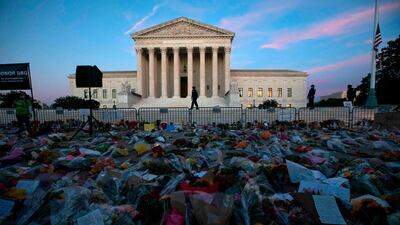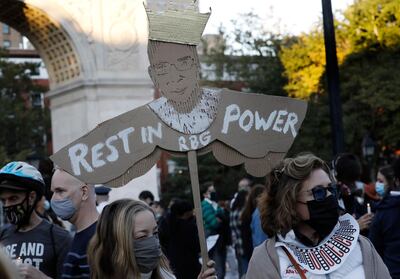The death of US Supreme Court justice Ruth Bader Ginsburg, leader of the court's liberals, will reshape the upcoming election and, quite possibly, the future of the court itself.
The justice was 87 and in deteriorating health. Despite a valiant effort, she could not hold out for the next president. She reportedly said her dying wish was not to be replaced until the next administration begins on January 20. Those wishes are unlikely to be respected.
Now, a remarkable series of variables come into play. Normally, the process is straightforward: the president nominates a candidate for the court who must then be confirmed by the Senate.
However, in this case it is by no means so simple.
That's because when Justice Antonin Scalia died in 2016, the final year of Barack Obama's presidency, the Senate majority leader, then as now Mitch McConnell, refused to grant the president's nominee a hearing, let alone a vote.
Mr McConnell invented a preposterous theory, supposedly based on historical precedent but obviously and crudely concocted, arguing that although there were 10 months to go in Mr Obama's presidency, the Senate should wait to see what happened.
"The American people should have a voice in the selection of their next Supreme Court justice," he insisted. He has described that breathtakingly cynical manoeuvre as one of the proudest moments in his career. And because Donald Trump won in 2016, his alternative nominee, Neil Gorsuch, joined the court instead of Mr Obama's candidate, Merrick Garland.

If 10 months is too soon for a confirmation process, the 45 days now remaining before the November 3 election must surely be even more implausible. But of course, Mr McConnell is insisting that Mr Trump should nominate someone and the Senate vote immediately.
This remarkable ethical contortion is, if anything, being outdone by Senate Judiciary committee chairman Lindsay Graham, who insisted in 2016 "I want you to use my words against me. If there’s a Republican president in 2016 and a vacancy occurs in the last year of the first term, you can say Lindsey Graham said let’s let the next president, whoever it might be, make that nomination.”
Now that this is exactly what has happened, however, to no one's surprise he insists, "the rules have changed."
Mr Trump says he will nominate a woman shortly. If she is confirmed, he will have appointed three of nine Supreme Court justices and finally created the long-sought but elusive six-three conservative majority that Republicans have been seeking for decades. But it will have been done in such an underhanded manner that Democrats may seek extraordinary redress in the future.
The refusal to consider Mr Garland was outrageous enough. But if Republicans now ignore the very standard that they bucked all traditions to set four years ago, Democrats are likely to conclude the court is hopelessly politicised and that the other side has decided to stop at absolutely nothing in order to ideologically shape its rulings.
Moreover, many Democrats will view this looming six-justice court majority as yet another manifestation of a growing crisis of sustained minority rule in the US, which is grossly at odds with the country's democratic ideals.
Mr Trump is president because of the electoral college, not majority will, since Hillary Clinton got almost 3 million more votes than he did. Yet he may appoint one third of the Court’s justices. And the Republican Senate majority represents an even smaller minority of American citizens than he does, because the Constitution gives each state two Senators without regard to population.
The final straw will be the shamelessness of this manipulation, first creating new rules and then ditching them, despite passionately insisting they would never do that.
Since the Garland fiasco, some prominent Democrats have been quietly discussing the need to redress the conservative stranglehold on the Supreme Court and other high appellate courts by, when possible, using legislative authority to reshape and expand these courts.
There is nothing in the Constitution specifying nine justices on the Supreme Court. That is a function of 19th century legislation. A co-operative Congress and president could decide that 13, 15 or 17 justices should serve.
If Democrats take control of both houses of Congress and the White House next year, as they might well, they will probably attempt such "court balancing." Republicans will denounce it as "court packing," and compare it to a notorious failed effort to expand the court by Franklin Roosevelt in the 1930s. But given their recent conduct, Republicans will not have much credibility when championing traditions, propriety and norms related to the court.
Democrats may seek similar structural changes to many appellate courts, which Mr Trump and Mr McConnell have been busily packing, often with unqualified candidates.
The looming fight over the next justice could have a significant impact on the election, but it is extremely hard to tell which side, if either, may be advantaged, although turnout will be decisive.
This will certainly remind many conservative voters, who are uneasy with Mr Trump's personal conduct and style, why they voted for him in 2016, and it should be very good for his turnout.
But there is a good chance it will be at least as energising for an infuriated Democratic base, especially those women and men who are justifiably concerned this new court majority could spell the end of reproductive freedom in much of the country.
Just when it seemed the stakes couldn't be higher for November 3, they have been significantly amplified for both camps.
But there is a possible wrinkle. Four Republican senators, fearful for their own re-election chances or appalled with their leadership’s behaviour, could join Democrats in preventing the confirmation of a new justice before the election. But that would mean going into very serious potential post-election litigation with an even number of justices, possibly incapable of making a binding decision.
It seems more likely that Mr McConnell and Mr Trump will get their way by the narrowest of margins, but that this could spell the end for the familiar nine-member US Supreme Court.
Hussein Ibish is a senior resident scholar at the Arab Gulf States Institute and a US affairs columnist for The National




